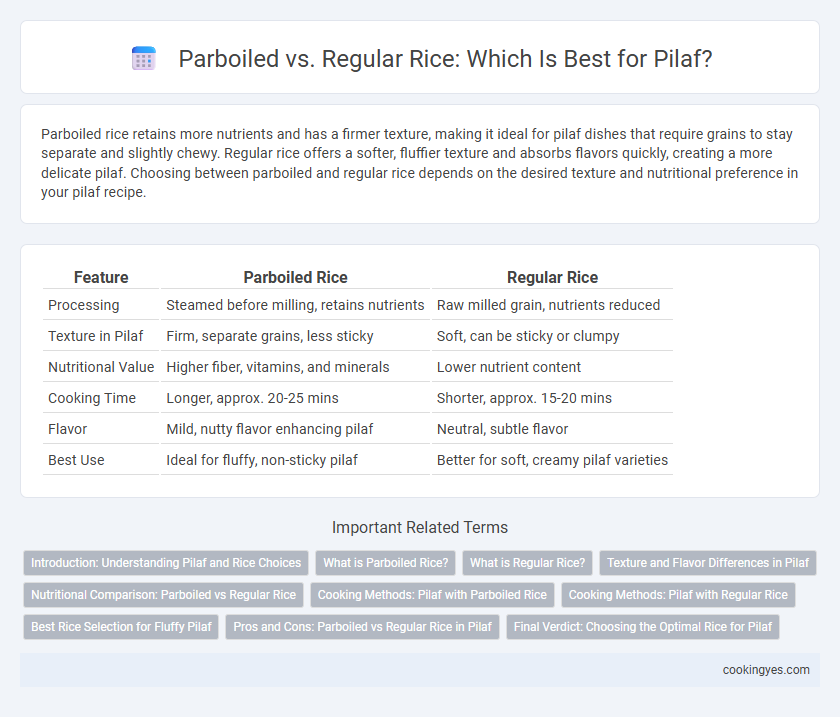Parboiled rice retains more nutrients and has a firmer texture, making it ideal for pilaf dishes that require grains to stay separate and slightly chewy. Regular rice offers a softer, fluffier texture and absorbs flavors quickly, creating a more delicate pilaf. Choosing between parboiled and regular rice depends on the desired texture and nutritional preference in your pilaf recipe.
Table of Comparison
| Feature | Parboiled Rice | Regular Rice |
|---|---|---|
| Processing | Steamed before milling, retains nutrients | Raw milled grain, nutrients reduced |
| Texture in Pilaf | Firm, separate grains, less sticky | Soft, can be sticky or clumpy |
| Nutritional Value | Higher fiber, vitamins, and minerals | Lower nutrient content |
| Cooking Time | Longer, approx. 20-25 mins | Shorter, approx. 15-20 mins |
| Flavor | Mild, nutty flavor enhancing pilaf | Neutral, subtle flavor |
| Best Use | Ideal for fluffy, non-sticky pilaf | Better for soft, creamy pilaf varieties |
Introduction: Understanding Pilaf and Rice Choices
Pilaf requires rice varieties that absorb flavors and maintain separate grains during cooking, making the choice between parboiled and regular rice crucial. Parboiled rice retains more nutrients and has a firmer texture, ideal for pilaf recipes needing distinct, non-sticky grains. Regular rice offers a softer, more delicate texture that can complement pilaf if cooked carefully to avoid clumping.
What is Parboiled Rice?
Parboiled rice is partially boiled in the husk, which drives nutrients from the bran into the grain, enhancing its nutritional value and making it less sticky when cooked. This process results in firmer, separate grains ideal for pilaf, as they absorb flavors without becoming mushy. Regular rice, by contrast, lacks this treatment, leading to a softer texture that may clump together during pilaf preparation.
What is Regular Rice?
Regular rice typically refers to white rice that has been milled to remove the husk, bran, and germ, resulting in a polished grain with a softer texture and quicker cooking time. This type of rice absorbs flavors efficiently but can become sticky or mushy if overcooked, which may affect the texture of pilaf dishes. Common varieties of regular rice used in pilaf include long-grain types like basmati or jasmine, prized for their fluffy, separate grains after cooking.
Texture and Flavor Differences in Pilaf
Parboiled rice maintains a firmer, chewier texture and holds its shape better during cooking, making it ideal for pilaf dishes that require distinct grains without clumping. Regular rice tends to produce a softer, fluffier texture with a more delicate flavor, which can absorb spices and broth more readily in pilaf recipes. The nutty, slightly toasted flavor of parboiled rice contrasts with the mild, neutral taste of regular rice, influencing the overall flavor profile of the pilaf.
Nutritional Comparison: Parboiled vs Regular Rice
Parboiled rice retains more nutrients such as vitamin B6, magnesium, and potassium compared to regular white rice due to the steaming process that drives nutrients from the bran into the grain. Regular rice often has a higher glycemic index, causing quicker spikes in blood sugar, while parboiled rice provides a more stable energy release. This nutritional advantage makes parboiled rice a healthier choice for pilaf recipes focused on sustained energy and nutrient density.
Cooking Methods: Pilaf with Parboiled Rice
Parboiled rice is ideal for pilaf due to its firm texture and resistance to overcooking, allowing grains to remain separate and tender throughout sauteing and simmering steps. The parboiling process partially gelatinizes starches, enhancing the rice's ability to absorb broth without becoming mushy, which is crucial for fluffy, flavorful pilaf. Cooking parboiled rice using the pilaf method requires toasting the rice in oil or butter before adding hot stock, ensuring even cooking and maximizing flavor absorption.
Cooking Methods: Pilaf with Regular Rice
Cooking pilaf with regular rice requires rinsing the grains to remove excess starch, ensuring a fluffy texture without clumping. Sauteing the rice in oil or butter before adding broth helps to evenly coat the grains and enhance nutty flavors. Simmering with a precise ratio of liquid to rice and avoiding stirring during cooking preserves the separate, tender grains ideal for a perfect pilaf.
Best Rice Selection for Fluffy Pilaf
Parboiled rice is ideal for fluffy pilaf due to its firmer texture and lower starch content, which prevents clumping and ensures separate, distinct grains. Regular long-grain white rice can become sticky and less fluffy because of its higher surface starch. For best results, choose parboiled rice varieties like Uncle Ben's or converted rice to achieve the perfect fluffy pilaf consistency.
Pros and Cons: Parboiled vs Regular Rice in Pilaf
Parboiled rice offers enhanced texture and firmness for pilaf, preventing clumping and absorbing flavors effectively, while its longer cooking time can be a drawback. Regular rice provides a softer, fluffier texture favored in traditional pilaf dishes but tends to stick together and may become mushy if overcooked. Choosing between parboiled and regular rice depends on desired pilaf consistency, cooking time, and flavor absorption preferences.
Final Verdict: Choosing the Optimal Rice for Pilaf
Parboiled rice offers firmer, less sticky grains ideal for pilaf dishes that require distinct texture and moisture absorption, while regular white rice provides a softer, fluffier result preferred for traditional pilafs. The choice depends on desired texture; parboiled rice yields more structural integrity during cooking, preventing mushiness, whereas regular rice delivers a delicate, tender finish. For pilaf recipes emphasizing grain separation and bite, parboiled rice is optimal, whereas regular rice suits recipes favoring creamy consistency.
Parboiled vs Regular Rice for Pilaf Infographic

 cookingyes.com
cookingyes.com